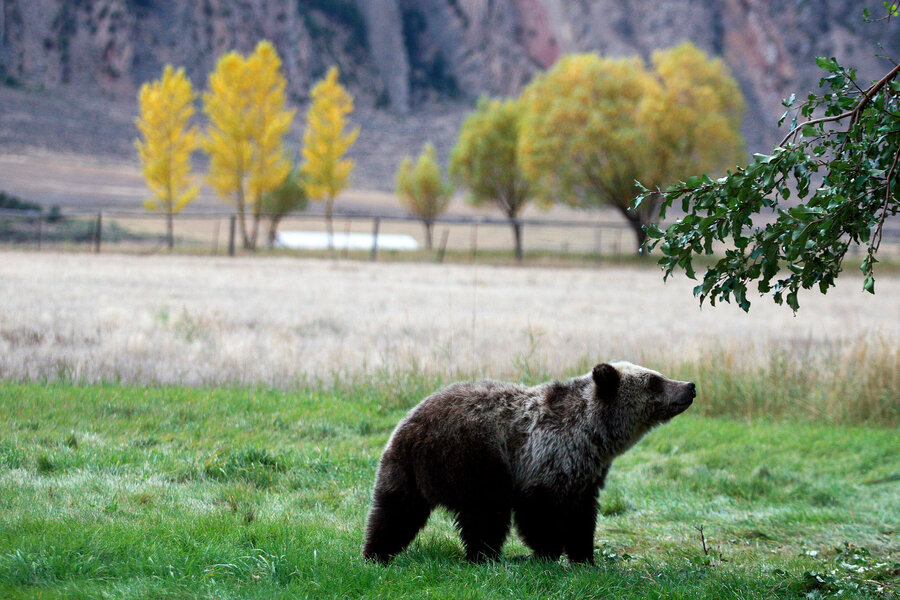Yellowstone's grizzly bears are back
Loading...
Long-ago visitors to Yellowstone National Park didn't want to miss the eruption of Old Faithful, the majestic mountain views, and nightly bear watches, during which wooden bleachers were set up around garbage dumps where grizzly bears came to eat.
Old Faithful's geyser theatrics remain regular, and the nation's oldest park continues to inspire its visitors, but things have changed for the grizzly bears.
The U.S. Fish and Wildlife Service announced Thursday that grizzly bears have made a thorough recovery and can be delisted from the Endangered Species Act, a milestone sign that conservation can succeed for a population devastated by hunting in the 1900s.
"This is really momentous, bigger than recovering the bald eagle," says Todd Wilkinson, an environmental writer in Montana and author of the book "Grizzly: The Bears of Greater Yellowstone." "This is recovering a fearsome and inspiring large mammal."
The bears' journey took them from a near-extinction low of 136 bears in the Yellowstone area to a thriving population of between 700 and 1,000 bears (depending on the counting methodology), in and around Yellowstone National Park. The grizzly bears have been a challenging population to rehabilitate, partly because they reproduce very slowly, with a female giving birth once every three years at most, Mr. Wilkinson says.
"I think what we have here is a tremendous success, and the Endangered Species Act has done its job," Fish and Wildlife Service Director Dan Ashe said in a press conference, adding that grizzly bears have doubled their range since they were added to the Endangered Species Act in 1975.
The announcement comes just as Yellowstone's grizzly bears are beginning to emerge from winter hibernation. Park Service officials said the first bear wandered through the snow near Old Faithful on Feb. 22, Ben Pierce wrote for the Bozeman Daily Chronicle.
“He was wandering looking for a carcass,” Amy Bartlett of the Yellowstone Public Affairs office told the Bozeman Daily Chronicle. “This is on par with when male grizzly bears emerge, usually around the first week of March.”
This is prime time for the males, at least, to emerge from winter slumber. Females and cubs usually wait, but the park service began closing select areas to visitors to try and minimize ursine-human encounters. Such encounters have been increasing of late, which is one reason the Fish and Wildlife Division has been pressured to remove the grizzly bears from the endangered species list.
Not everyone is excited about the announcement. Roger Hayden managing director for Wyoming Wildlife Advocates in Jackson Hole, called Thursday's announcement "a couple years too early." He says bears are roaming the periphery more frequently now, searching for meat to supplement their diet because white bark pine and cutthroat trout have declined due to climate change and other shifts in the ecosystem.
"The question we keep raising is, 'What is the rush to delist and why can’t we wait to delist them for a couple years?'" Mr. Hayden says.
He and other wildlife advocates, including the Sierra Club and the Center for Biological Diversity, say the bear population could be in decline – a record 59 died in 2015 – because their food source is threatened. The federal government says the shifting population is a sign that the Yellowstone area has reached its carrying capacity for grizzly bears.
"There is robust agreement that this population has recovered," Mr. Ashe said in a press conference. "It's been stable for more than a decade, and it’s at its carrying capacity."
Hayden says he worries that once their care is returned to the states, Wyoming, Idaho, and Montana all intend to begin trophy hunts of the grizzly bears. States have not made final decisions, but they could use the funds from such hunts, which have not occurred since 1974, to reimburse ranchers whose livestock is killed by bears.
This is not the end of grizzly bears' journey to full recovery, and Ashe emphasized that a rigorous five-year post-delisting plan will guide the states' management decisions.
"The job of the Endangered Species Act to avert the threat of extinction and to achieve recovery is done," Ashe said. "It’s now our obligation to delist the population and return management to the state."





